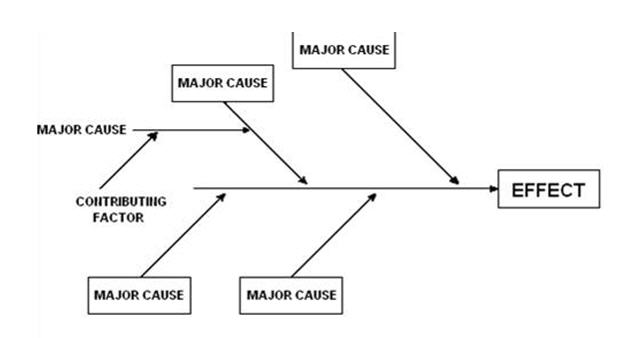Root Cause Analysis may sound daunting but it is not intended to be. It is simply an organisational tool for conducting an investigation into any identified (Typically through Quality Audit) finding, problem, concern or non-conformity; of course it may also be used in dealing with incidents or accidents.
In Root Cause Analysis we focus on looking beyond the immediate solution to the underlying causes of the issue. Typically we are looking predominantly at organisational factors, Process, Procedures, Management Controls, Facilities, Tooling & Equipments, Resources, Training, and Culture and Behaviour.
For our practical solution we will consider using “Fish-bone,” or cause-and-effect diagram (also known as Ishikawa diagrams). The use of this graphical representation of the issue allow us to see in visual way a representation of inputs (causes and reasons) relating to our issue and an output (the problem or event which we have experienced or which we currently observe).
This graphic helps identify root causes, inefficiencies, and others issues. Ishikawa diagrams are in fact quite similar to other quality tools. Using the tool the responsible person identifies all the sub elements and organizes in a visual way. As simple as it sounds, often just getting all the notions and ideas organized into such a diagram has a positive effect in the understanding (diagnosis) and mitigation (resolution).
The primary benefit of Root Cause Analysis is that it provides for the Identification of a permanent solution, moreover it can aid the prevention of recurring failures.
In the case of a complex non-conformity involving multiple factors root cause analysis becomes proportionally more involved taking some time to accomplish.
Remember that it is the role of the auditee (not the auditor) to understand the “Root Cause” and the appropriate mitigations. It is important not to loose sight of the role of Quality Assurance being to identify the gaps and advise and support the business area owner with appropriate support and guidance.
The precursor to the need to identify the Root Cause is of course the finding. So at this point we will understand “What is non-conformity which is evident”. We may also consider as a factor when it was discovered and how long it has been an issue?In addition, to consider how many areas / products or processes are in fact implicated.
Key event stages include:
a) Understand in detail the Specific Problem
b) Deal with any immediate “critical” issues
b) Establish “all” elements which contribute to the Specific Problem.
c) Consider the opportunities to develop mitigations for each of the elements identified
d) Obtain approval
e) Implement the (Mitigation) Solution
f) Test the mitigation for effectiveness

Throughout the process it should be remembered that the key question that root cause analysis is seeking to answer is: What system or process failed so that this problem could occur?
We should keep asking the same key question when striving for the “root cause”.
What was the process or element of the process which failed to enable the problem to manifest itself?
Consider using the above Diagram as a guide that .The final effect is our issue or problem. That a Major Cause can be directly impacted by another Major Cause or indeed by a Contributing Cause. Consider the following as potential issues with which to “test” our understanding of cause
a) Manpower – Numbers & Availability (Where there any fatigue related issues
b) Competency Issues – Did the People involved have the necessary competence – Knowledge / Experience / Training /
c) Procedures & Process – Procedures available and understood / Process tested and normally error free
d) Tooling & Equipment Related – Tooling & Equipment available in the correct numbers where it was needed & when it was needed
e) Behaviour and Cultural Issues – Company Norms – Organisational Violations
For some issues the root cause may appear to be obvious when we ask the question – ’Why did this occur?’ And the answer will be for example:
a) The procedure did not include this requirement or
b) The procedure has not been trained
Whilst the answer and the resolution may seem obvious when we ask the question – ” Why?”.
The issue starts to look different, because we can go further and ask the question:
i/ Could it happen again? (Subjective)
ii/ Are there any other procedures which can also be in this situation? (Objective)
iii/ Who was managing this procedure – What was the reason for the shortfall? (Subjective)
iv/ Against what standard had the procedure been developed? (Objective)
v/ How had the procedure previously been tested? (Objective)
vi) Who is controlling the training? (Objective)
vii/ Are there other people who need training (objective)
viii / Who is managing and controlling the training – What was the reason for the shortfall? (Subjective)
Once all the information has been brought together it should be possible to start to develop our conclusions regarding the exposures, or where necessary to establish the area’s where further focus is required or additional questions need to be asked.
With this in place we can proceed to the action or implementation plan. The implementation plan must include both specific ownership and a defined time-scale in which the required action should be completed.
The final step which is critical to the success involves the activity associated with verification and ongoing monitor are effective and that we are satisfied that the outcomes and dealt with both the primary issue and any associated underlying issues.
Tags:
Aviation Quality Assurance, Quality Audit, Root Cause Analysis





